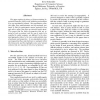576 search results - page 39 / 116 » Modeling Adversaries in a Logic for Security Protocol Analys... |
CTRSA
2009
Springer
14 years 2 months ago
2009
Springer
In the setting of multiparty computation a set of parties with private inputs wish to compute some joint function of their inputs, whilst preserving certain security properties (l...
TCC
2009
Springer
14 years 8 months ago
2009
Springer
The first and still most popular solution for secure two-party computation relies on Yao's garbled circuits. Unfortunately, Yao's construction provide security only again...
EUROCRYPT
2010
Springer
14 years 12 days ago
2010
Springer
A broadcast protocol allows a sender to distribute a message through a point-to-point network to a set of parties, such that (i) all parties receive the same message, even if the s...
CTRSA
2008
Springer
13 years 9 months ago
2008
Springer
Oblivious transfer, first introduced by Rabin, is one of the basic building blocks of cryptographic protocols. In an oblivious transfer (or more exactly, in its 1-out-of-2 variant...
CSFW
1998
IEEE
13 years 12 months ago
1998
IEEE
This paper applies the theory of Communicating Sequential Processes (CSP) to the modelling and analysis of a non-repudiation protocol. Non-repudiation protocols di er from authent...



